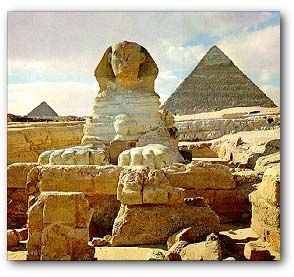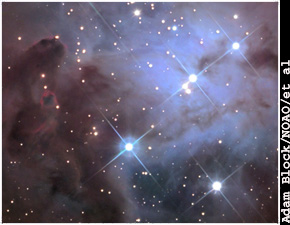|
Early Man

|
| Antient Egyptians were followers of the night sky. |
From the earliest of times man has looked to the heavens and saw the bright twinkling lights of the stars. Many an ancient
man saw the Sun as a God riding across the sky in a chariot of fire. The early Egyptians, who built the Great Pyramid, were
even fascinated by the night sky. In fact the three pyramids that are most recognized are layed out in the pattern of Orion's
belt. In fact many cultures looked to the sky to time the cycles of the seasons, which were crucial for planting and harvesting
crops.
As time moved on men like Pythagoras, Aristotle,and the inventor of Trigonometry, Hipparchus theorized about
the shape of the Earth. Many believing that the Earth was either flat or the center of the universe. One of the first to believe
that the Earth orbited the Sun was Aristarchus as early as 250 BC. Man also relied on the heavens to help them navigate the
seas. And many cultures used the appearance of of eclipses and comets as part of thier religious cerimonies and traditions.
Astronomy And The Church
It was Aristotle that theorized that the Earth, which always changed, was corrupted and that the heavens, which never
seemed to change, was pure. In 1200 AD the Catholic Church adopted these views, only taking them further by placing religious
applications with them. The Church said that the Earth contained Hell so it is the center of impurity, and that the heavens
were pure because that is where Heaven is. Therefore the Earth was surrounded by purity and being impure it must be the center
of the universe.
The Church was not challenged until 1610 when Galileo looked through the eyepiece of his newly invented
telescope. He looked around the night sky and saw that there was much more to see than could be seen with the eye alone and
after several observation sessions he theorized that the Earth orbited the Sun, then made his observations public. This angered
the Church who forced Galileo to denounce his views out of fear for his life. And even then lived out the rest of his days
under house arrest. The Catholic church did not absolve him from wronddoing until 1992.
Then just about 50
years later Sir Isacc Newton announced that he too believed that the Earth orbited the Sun. He also explained the tides and
theorized several laws of motion which helped later astronomers discover the outer planets. With Newton's work the Age of
Reason had begun.
From Newton To Now
What's Next?
Ever since Galileo looked at the moons around Jupiter for the first time we have made leaps and bounds in the world of astronomy
and learn more everyday. Now the Big Bang Theory is at question. We have our own names to remember with Galileo and Newton.
Names like Einstien or Hawkings. We look to the future of space exploration, and the first man that may step foot on Mars.
The internet makes astronomy available to all, with the ability to see what the scientist sees. With the first ever space
telescope, HST (Hubble Space Telescope), we are seeing further than ever into the heavens. Now with new, more advanced space
telescopes in the works we may look across the great devide and see an astronomer from a world far from our own looking back.
|

